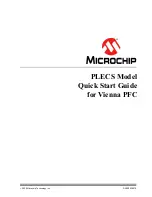Enhanced Time Processing Unit (eTPU2)
Freescale Semiconductor
29-3
PXR40 Microcontroller Reference Manual, Rev. 1
Shared Data Memory
-
SDM -
holds eTPU application parameters and work data. It is accessed by Host
and both microengines.
Bus Interface Unit - BIU
- allows Host to access eTPU registers, SCM and SDM.
Each I/O signal pair is associated with a dedicated
Channel
, which provides hardware for input signal
processing and output signal generation, in relationship with selected Time Bases.
The eTPU, as a microprocessed subsystem, works much like a typical real-time system: it runs
microengine code from instruction memory (SCM) to handle specific events, accessing data memory
(SDM) for parameters, work data and application state info; events may originate from I/O Channels (due
to pin transitions and/or time base matches), Host CPU requests or inter-channel requests; events that call
for local eTPU processing activate the microengine by issuing a
Service Request
. The Service Request
microcode may set an interrupt to the Host CPU. I/O channel events cannot directly interrupt the Host
CPU.
Each Channel is associated with a
Function
, which defines its behavior: the Function is a software entity
consisting, within the eTPU, of a set of microengine routines that attend to Service Requests. The Function
routines are also responsible for Channel configuration. Function routines reside in SCM, which may
contain several Functions. A Function may be assigned to several Channels, but a Channel can be
associated with just one Function at a given moment. The association between Functions and Channels is
defined by Host CPU, and is explained in detail in the
eTPU Reference Manual
.
eTPU hardware supplies resource sharing features that support concurrency:
•
a hardware
Scheduler
dispatches the Service Request microengine routines based on a set of
priorities defined by the Host CPU. Each Channel has its associated priority;
•
a Service Request routine cannot be interrupted until it ends. This sequence of uninterrupted
instruction execution is called a
Thread
.
•
Channel-specific context (registers and flags) is automatically switched between the end of a
Thread and the beginning of the next one.
•
SDM arbitration, a dual-parameter coherency controller and semaphores can be used to ensure
coherent access to eTPU data shared by both eTPU Engines and Host CPU.
Summary of Contents for PXR4030
Page 1: ...PXR40 Microcontroller Reference Manual Devices Supported PXR4030 PXR4040 PXR40RM Rev 1 06 2011...
Page 30: ...PXR40 Microcontroller Reference Manual Rev 1 Freescale Semiconductor xxx...
Page 40: ...PXR40 Microcontroller Reference Manual Rev 1 xl Freescale Semiconductor...
Page 66: ...Memory Map PXR40 Microcontroller Reference Manual Rev 1 2 4 Freescale Semiconductor...
Page 120: ...Signal Descriptions 3 54 Freescale Semiconductor PXR40 Microcontroller Reference Manual Rev 1...
Page 860: ...FlexCAN Module 24 50 Freescale Semiconductor PXR40 Microcontroller Reference Manual Rev 1...
Page 1167: ...Decimation Filter Freescale Semiconductor 28 53 PXR40 Microcontroller Reference Manual Rev 1...
Page 1168: ...Decimation Filter 28 54 Freescale Semiconductor PXR40 Microcontroller Reference Manual Rev 1...


















